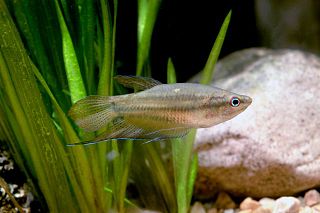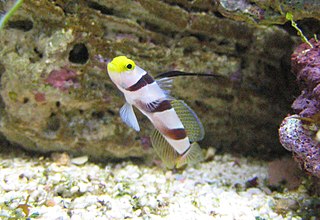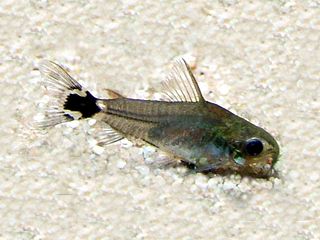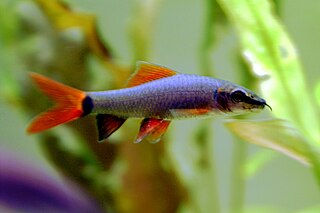
The black neon tetra is a freshwater fish of the characin family (Characidae) of the order Characiformes. It is native to the Paraguay basin of southern Brazil. They are often found in the aquarium trade.

The dwarf gourami is a species of gourami native to South Asia.

The royal gramma, also known as the fairy basslet, is a species of fish in the family Grammatidae native to reef environments of the tropical western Atlantic Ocean. They are commonly kept in aquariums.

The croaking gourami is a species of small freshwater labyrinth fish of the gourami family. They are native to still waters in Southeast Asia and are distributed worldwide via the aquarium trade. Croaking gouramis are capable of producing a "croaking" noise using their pectoral fins.

Stonogobiops nematodes, the Filament-finned prawn-goby, the Antenna goby, the high-fin goby, the red-banded goby, the high-fin red-banded goby, the striped goby, the barber-pole goby, or the black-ray Goby, is a species of marine goby native to the Indian Ocean and western Pacific Ocean from the Seychelles to the Philippines and Bali.

The pygmy gourami, also known as the sparkling gourami, is a freshwater species of gourami native to Southeast Asia.

The dwarf corydoras, dwarf catfish, tail spot pygmy catfish, or micro catfish is a tropical freshwater fish belonging to the subfamily Corydoradinae of the family Callichthyidae. It originates in inland waters in South America, and is found in the Amazon River and Paraguay River basins in Argentina, Bolivia, and Brazil. The specific epithet hastatus means with a spear, in reference to the spearhead-like spot on the tail root.

The yellow clown goby, Gobiodon okinawae, also known as the Okinawa goby or yellow coral goby, is a member of the goby family native to the western Pacific from southern Japan to the southern reaches of the Great Barrier Reef. As the name implies, they are bright yellow in color, save for a whitish patch on each cheek.

Hemigrammus erythrozonus, commonly known as the glowlight tetra, is a small tropical fish from the Essequibo River, Guyana, South America. It is silver in colour and a bright iridescent orange to red stripe extends from the snout to the base of its tail, the front of the dorsal fin being the same color as the stripe. Other fins are silver to transparent. The glowlight tetra is a peaceful, shoaling fish. It is larger than the neon tetra, and its peaceful disposition makes it an ideal, and popular, community tank fish. It should be kept with similar sized, non-aggressive species. Hemigrammus gracilis is a senior synonym. The red-line rasbora of Malaysia and Indonesia has markings and coloring very similar to H. erythrozonus, but is a member of family Cyprinidae, not a close relative.

Dichotomyctere ocellatus, commonly the figure 8 puffer or eyespot puffer, is a pufferfish found in freshwater in Southeast Asia. It is known from the lower reaches of the Mekong (Cambodia), the Peninsular Malaysia as well as Borneo.

The snakeskin gourami is a species of gourami native to Southeast Asia. Prior to the merging of Belontidae to the family Osphronemidae, the snakeskin gourami was regarded as the largest member of its family. It is still the largest species in its genus and subfamily.

Brachygobius is a small genus of gobies. They are popular aquarium fish where a number of species are sold as bumblebee gobies because their colours are similar to those of bumblebees.
Parachromis motaguensis, the false yellowjacket cichlid, is a species of cichlid native to Central America, where it can be found in Guatemala, El Salvador, and Honduras. This species grows to a length of 30 centimetres (12 in) TL. This species is farmed.

The rainbow shark is a species of Southeast Asian freshwater fish from the family Cyprinidae. It is also known as the ruby shark, red-fin shark, red-finned shark, rainbow sharkminnow, green fringelip labeo, whitefin shark and whitetail sharkminnow. It is a popular, semi-aggressive aquarium fish. Unlike true sharks, which belong to the Chondrichthyes lineage, the rainbow shark is an actinopterygiian.

The ember tetra is a freshwater fish of the characin family of order Characiformes. It is native to the Araguaia River basin of Brazil and was discovered in 1987 and named in honor of the fish explorer Heiko Bleher's mother.

Apistogramma panduro (A-183), also commonly referred to as Apistogramma pandurini, is a small species of cichlid freshwater fish from the Amazon river basin in Peru. It is closely related to A. nijsseni, so much so that they are placed in the A. nijessni species group. Some common names for A. panduro are blue panda apisto, and Panduros’ apisto.

The violet goby is a species of goby native to marine, fresh and brackish waters near the Atlantic coast of North and South America from South Carolina in the United States of America, to northern Brazil. It prefers bays, estuaries and river mouths with muddy substrates. It is often marketed as the dragon goby or dragon fish.

Stigmatogobius sadanundio is a species of goby native to south Asia from India to Indonesia including Sri Lanka and the Andaman Islands. It can be found in mostly fresh waters of estuaries and the tidal zones of rivers. It can also be found in the aquarium trade, where it is often marketed as the knight goby.

Betta pi is a species of gourami belonging to the genus Betta. It is found in the Pru Toe-Daeng peat swamps in Narathiwat Province in Southern Thailand, but its range also extends into northern Peninsular Malaysia, most notably the states of Kelantan and Terengganu. It is primarily found in well-shaded peat forest blackwater swamps and creeks where the pH can be as low as 3.0 or 4.0. It is benthopelagic. It can grow to a maximum length of 9.0 cm (3.5 in). It is a fish of mild importance in the aquarium industry. Its diet consists of aquatic invertebrates in the wild, but will also eat frozen, live and dried foods such as larva of Chironomidae, Daphnia, and brine shrimp in aquariums.
Brachygobius sabanus is one of 8 species of goby in the Brachygobius genus, which all share the common name of bumblebee fish or bumblebee goby due to their characteristic black and yellow stripes. Over the past two centuries, efforts to distinguish different species within the Brachygobius genus have occurred within scientific literature; Brachygobius sabanus was described within literature as its own species in 1958, by Robert F. Inger. Other gobies within the genus are B. nunus, B. doriae, B. alcocki, B. sua, B. xanthomelas, B. aggregatus, and B. kabiliensis.

















